Ghost Ranch Restoration Project
ABQ BioPark staff volunteer their time for conservation work at Ghost Ranch in northern New Mexico.
Animals and Plants Identified
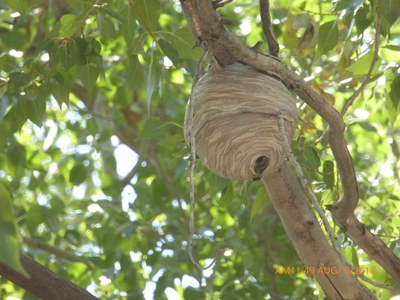
Staff inventoried a number of arthropods, plants and mammals during the trip including:
- Digger bee
- Robber fly
- Hornless rhinoceros beetle
- Fourwing saltbush
- Louisiana sage
- Wyoming Indian paintbrush
- Antelope sage
- Hairy golden aster
- Large flower hawk’s beard
- Mule deer
- Western bluebirds
- Brown long-eared bats
- Woodhouse toads
Photo: Bald-faced hornet nest.
Oct. 3, 2018 - In 2015, Ghost Ranch near Abiquiú, NM, suffered a catastrophic flash flood, which caused significant damage to historic buildings and the surrounding landscape. The flood damage posed environmental risk to the historic site, as well as to the adjacent Rio Chama watershed.
The ABQ BioPark took part in a planting workshop alongside Keystone Restoration Ecology and Ghost Ranch Administration August 3-5. Eight BioPark staff and two volunteers with specialties in plants, arthropods and mammals participated in this special project to help restore the Arroyo del Yeso floodplain and its surrounding landscape.
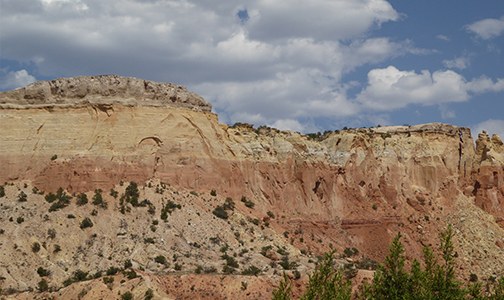
These staff volunteered their weekend to plant more than 1,000 native tree and shrub seedlings and grass plugs that were grown at the BioPark for the project as part of a New Mexico BioPark Society conservation grant award. Additionally, more than 100 willow pole cuttings were taken on-site from Ghost Ranch and replanted on the devastated Arroyo del Yeso flood plain.
“The experience was overall, a valuable team-building opportunity to bring together diverse members of the BioPark staff and associated community and to provide an opportunity for people to connect outside of work and learn more about each other and what motivates them as part of the BioPark,” said Maria Thomas, project team leader and ABQ BioPark curator of plants.
She also said the project served as a template for establishing a larger-scale plant conservation program at the BioPark, an important consideration as the facility moves forward with the horticulture component of the 20-year Master Plan. She said understanding this process is helpful in developing and maintaining future conservation programming and exhibits at the BioPark such as the Cottonwood Gallery.
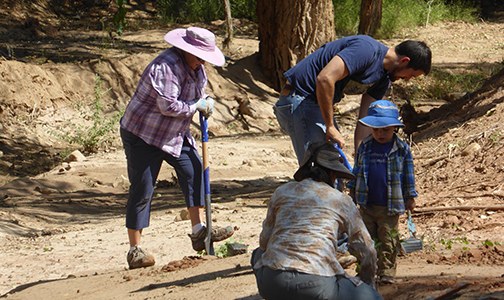
“The opportunity for BioPark staff to conduct fieldwork also served to enrich staff knowledge and expertise in multiple areas,” Thomas said. “Staff received on-site training by professional hydrologists and ecologists on watershed restoration including natural channel design and Induced meandering techniques.”
Plant and arthropod identification and training on plant siting and restoration planting techniques was also conducted by Keystone Restoration Ecologists, BioPark curatorial staff, and Judith Phillips, a licensed landscape architect and member of the Native Plant Society of New Mexico.
In addition, staff conducted plant, arthropod, amphibian, bird, and mammal inventories and identified 71 species of plants and 20 species of arthropods. Wild birds, mammals, and amphibians were also noted including mule deer, western bluebirds, brown long-eared bats, and woodhouse toads.
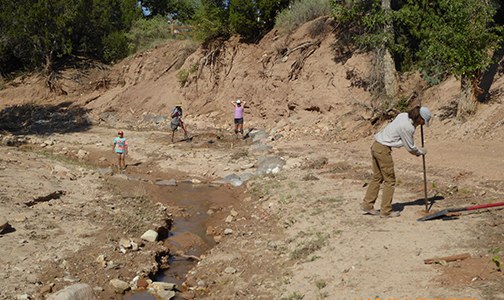
“This was exciting to staff and volunteers, as no one involved in the project could find any background information or research documents, barring paleontology, on the natural history of the Ghost Ranch area before departing on the trip,” said Thomas.
“My favorite part of this trip was our plant survey hike, where our garden curators and native plant experts were quick to identify and point out the many plants that occurred in the area, the river ecologists described how the stream and its flooding affected the landscape, and staff from different areas of the BioPark were able to point out wildlife in their areas of expertise,” said Katie Carillo, ABQ BioPark aquarium/Botanic Garden education clerk.
BioPark staff collected seed from eight native herbaceous wildflower species and collected seven 40-gallon bags of premium oak mulch for BioPark arthropod exhibits and food. A return seed collection trip occurred at the end of September. This seed will be used to enhance BioPark plant collections, continue to restore the riparian areas impacted by the flood, and preserve the ecological diversity of New Mexico habitats. In addition, as the BioPark partner with UNM in climate change studies, the seeds collected and grown from Ghost Ranch can be used to provide important data about how climate change will affect our native ecosystems.
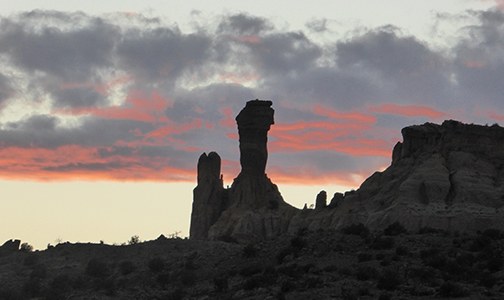
“Overall, it was an amazing trip full of partnership, hard work, and professional and personal growth for all involved,” said Thomas. “I look forward to returning to Ghost Ranch to see the effects of our efforts and to continue the great work we began in August.”
Melissa Tapia-Garcia, ABQ BioPark assistant curator of horticulture, added, “This was a wonderful project to work on with some amazing people. We planted many different species of plants and grasses in some interesting areas.”
What Staff Volunteers Said About the Project
Cecilia Hernandez, ABQ BioPark gardener
“This project began for me many months before the trip out to Ghost Ranch. As the caretaker of one of the nurseries at the BioPark, I nurtured the 450 tree and shrub seedlings that arrived in bareroot bunches, from leafless twigs into healthy vibrant plants that set down roots beyond their pots. Knowing they were destined for the wild, I did my best not to baby them but limitations on time, space and materials made it so that the focus was on keeping them alive, rather than preparing them for the environment to come. I am eager to see how they adapt over time.”
Lisa Moore, ABQ BioPark senior zookeeper
“My passion may lie with mammals, but through the tracks left in the damp earth, I realize the power in a healthy environment supports the healthy presence of wildlife. Stepping away from my work at the zoo and into our local wild areas brought a renewal in all we stand for, and promote, at the ABQ BioPark. I look forward to seeing the new growth take root, creating a stable home for more White-tailed deer, western bluebirds, and the sly coyotes.”
Judith Phillips, ABQ BioPark docent, landscape architect and member of Native Plant Society of New Mexico
“We were lucky. Rain had soaked the planting area a few days earlier so the soil was as easy to work as it ever can be in New Mexico. There was still a trickle of water in the low-flow meander in part of the planting area. What a bonus, being able to bucket water to new transplants! The other bonus was the planting crew. Shovel-ready and quick to laugh. Bravo!”
Jason Schaller, ABQ BioPark curator of entomology
“The Ghost Ranch vegetation restoration project was an excellent team building experience for all involved. Additionally, I was able to document some interesting arthropods while collecting copious amounts of rotting oak leaf mulch with the permission of the property managers. Quality rotting oak leaf mulch without pine needles or other contaminants is a priceless resource for the Bugarium Rearing laboratory–we use it to grow eight species of beetle, several millipedes, and several cockroaches. The quality and accessibility of this mulch will be useful indefinitely.”
